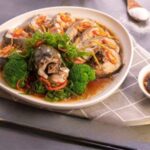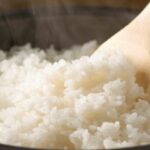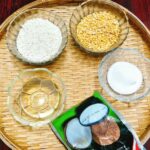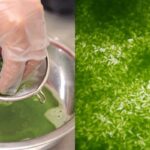Choosing the Best Glutinous Rice
Selecting high-quality glutinous rice is key to making delicious sticky rice. Typically, when preparing sticky rice, people opt for glutinous rice with a flower-shaped brand, as it tends to be less prone to shrinkage during cooking, resulting in evenly sized, shiny, and fragrant grains.
Additionally, varieties such as Dien Bien glutinous rice, Tu Lei glutinous rice, goose glutinous rice, and velvet glutinous rice are also preferred for making sticky rice due to their optimal combination of stickiness and aroma.
When purchasing glutinous rice, look for grains that are round, shiny, and opaque white in color, emitting a pleasant scent of fresh rice.
Preparing the Rice
Both glutinous rice and non-glutinous rice primarily consist of starch, which is made up of two inseparable components: amylopectin (mainly found in the outer layer) and amylose (located in the endosperm). While amylose dissolves in water, amylopectin, a polysaccharide and a highly branched polymer of glucose, provides stickiness and does not dissolve in cold water. However, when exposed to hot water for an extended period, it swells and forms a thick paste.
The distinction between glutinous rice and non-glutinous rice lies in their amylopectin and amylose ratios. Glutinous rice contains 98% or more amylopectin, whereas non-glutinous rice has a lower proportion of this substance. Consequently, glutinous rice requires less water during cooking yet remains sticky (typically prepared through steam cooking); non-glutinous rice, on the other hand, demands more water for the grains to expand and attain a sticky texture.
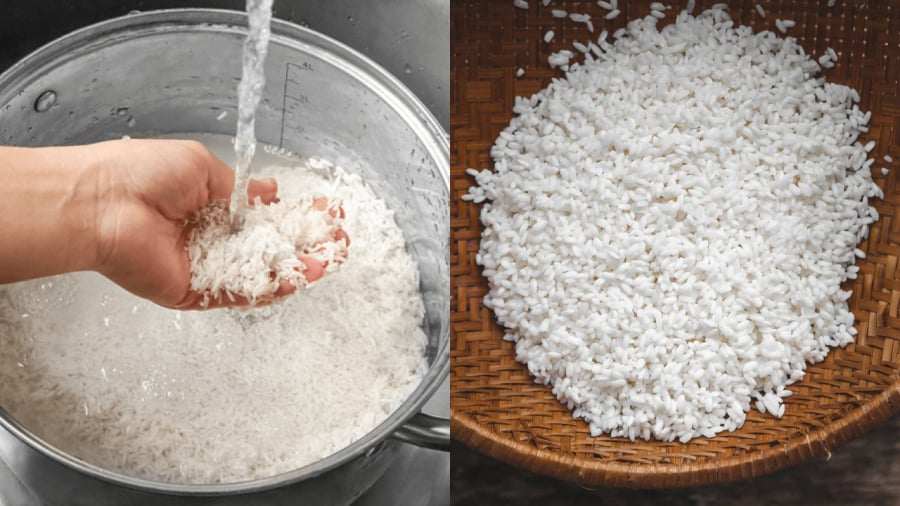
Typically, glutinous rice is soaked for 6-8 hours before cooking to ensure it absorbs enough water.
After purchasing glutinous rice, gently rinse it to remove any dirt or impurities. Conventionally, the rice is soaked in water for at least 6-8 hours to allow it to absorb sufficient water, ensuring even cooking and a soft, sticky texture when steamed. During soaking, add a pinch of salt to enhance the flavor and prevent the rice from souring due to prolonged soaking. Once the rice has absorbed enough water, it’s ready for steaming.
However, if you’re short on time or need to prepare sticky rice unexpectedly, there are alternative methods you can employ.
– Soaking in Hot Water
Instead of soaking the rice overnight in cold water, you can use hot water. Place the cleaned rice in a container of hot water and soak it for about 30-40 minutes. Then, drain the water and proceed to steam the rice.
– Blanching in Boiling Water
For an even faster method, you can blanch the glutinous rice in boiling water. Bring a pot of water to a rolling boil and add the rice, stirring continuously for about 30-40 seconds, depending on the variety and freshness of the rice. For flower-shaped glutinous rice or Thai glutinous rice, 30 seconds should suffice, while goose glutinous rice or velvet glutinous rice may require up to 40 seconds. Afterward, quickly drain the rice to remove excess water.
Note: Avoid soaking or blanching the rice for too long, as it can cause the amylopectin to expand, resulting in sticky rice that becomes overly soft and sticky during steaming.
Steaming the Sticky Rice
The proper way to cook sticky rice is by using steam. Some people cook sticky rice similarly to how they cook regular rice, but this method is typically referred to as cooking glutinous rice rather than making sticky rice. Sticky rice steamed with vapor tends to have a superior sticky texture and is less likely to become overly soft and sticky compared to the regular rice cooking method.
Once the rice has drained, mix in a small amount of chicken fat or cooking oil along with salt to enhance the flavor and add shine. Depending on your preferred cooking method, you can also mix in sugar or coconut milk at this stage.
Line a steamer basket with a thin cloth and pour the rice onto it. To infuse more aroma into the rice, line the bottom of the steamer with pandan leaves before adding the rice. Use the tip of a chopstick or your finger to poke a few large holes through the rice to create steam vents, ensuring even heat distribution.
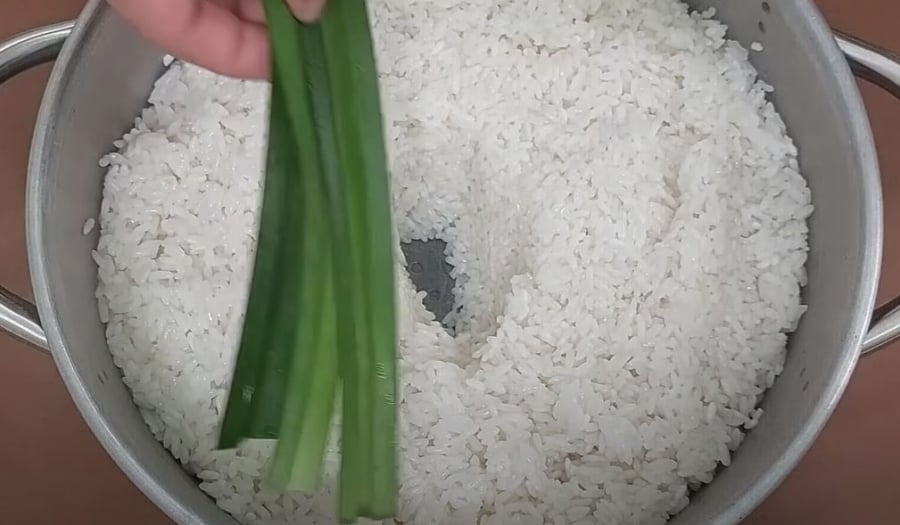
Adding pandan leaves during steaming enhances the aroma of the sticky rice.
Bring a pot of water to a boil and place the steamer basket on top. Cover and steam over high heat for about 5 minutes. Then, uncover and gently fluff the rice. Continue steaming for another 5 minutes over high heat to ensure even cooking.
Another trick to achieving perfectly sticky rice that stays delicious even when cooled is to steam the rice twice. After the first round of steaming, when the rice is already soft, spread it out on a large plate or tray and fan it to cool it down. Just before serving, sprinkle a little cold water over the rice and return it to the steamer for a second round of steaming to ensure the rice absorbs moisture, cooks evenly, and becomes plump.

Steaming the sticky rice twice is a clever technique to ensure it stays delicious even when cooled.
How to Cook Sticky Rice in a Rice Cooker: A Foolproof Guide to Deliciousness
“The perfect sticky rice dish is just a few simple steps away. With this easy-to-follow guide, you’ll be able to create a delicious and fragrant sticky rice using your rice cooker, without the hassle and time-consuming efforts usually associated with this dish. It’s a quick and efficient way to enjoy a flavorsome treat.”

























